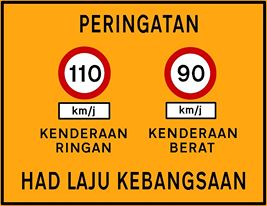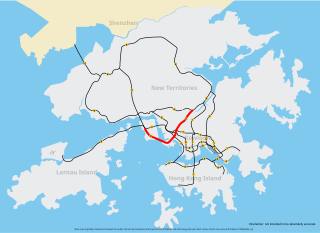Related Research Articles

Tsing Ma Bridge is a bridge in Hong Kong. It is the world's 16th-longest span suspension bridge, and was the second longest at time of completion. The bridge was named after the two islands it connects, namely Tsing Yi and Ma Wan. It has two decks and carries both road and rail traffic, which also makes it the largest suspension bridge of this type. The bridge has a main span of 1,377 metres (4,518 ft) and a height of 206 metres (676 ft). The span is the longest of all bridges in the world carrying rail traffic.

A dual carriageway (BrE) or a divided highway (AmE) is a class of highway with carriageways for traffic travelling in opposite directions separated by a central reservation (BrE) or median (AmE). Roads with two or more carriageways which are designed to higher standards with controlled access are generally classed as motorways, freeways, etc., rather than dual carriageways.

The expressways of Singapore are special roads that allow motorists to travel quickly from one urban area to another. Construction of the system was authorized when construction of the Pan Island Expressway began in 1962. All of them are dual carriageways with grade-separated access. They usually have three to four lanes in each direction, although there are two-lane carriageways at many expressway intersections and five-lane carriageways in some places. There are ten expressways. Studies about the feasibility of additional expressways are ongoing.

The road hierarchy categorizes roads according to their functions and capacities. While sources differ on the exact nomenclature, the basic hierarchy comprises freeways, arterials, collectors, and local roads. Generally, the functional hierarchy can more or less correspond to the hierarchy of roads by their owner or administrator.

A limited-access road, known by various terms worldwide, including limited-access highway, dual-carriageway, expressway, and partial controlled-access highway, is a highway or arterial road for high-speed traffic which has many or most characteristics of a controlled-access highway, including limited or no access to adjacent property, some degree of separation of opposing traffic flow, use of grade separated interchanges to some extent, prohibition of slow modes of transport, such as bicycles, (draught) horses, or self-propelled agricultural machines; and very few or no intersecting cross-streets or level crossings. The degree of isolation from local traffic allowed varies between countries and regions. The precise definition of these terms varies by jurisdiction.

Tuen Mun Road is a major expressway in Hong Kong which connects Tuen Mun with Tsuen Wan, within the New Territories. It is part of Hong Kong's Route 9, which circumnavigates the New Territories. Opened in 1978, it was once the major trunk route linking the northwest New Territories to urban Kowloon and is known for its frequent traffic jams and road accidents owing to its early design and heavy usage. As a result, speed limits have been enforced to 70–80 km/h (45–50 mph) due to geometric constraints.

A controlled-access highway is a type of highway that has been designed for high-speed vehicular traffic, with all traffic flow—ingress and egress—regulated. Common English terms are freeway, motorway and expressway. Other similar terms include throughway and parkway. Some of these may be limited-access highways, although this term can also refer to a class of highways with somewhat less isolation from other traffic.

Tsing Long Highway is an expressway of Route 3 from North West Tsing Yi Interchange on Tsing Yi Island to Yuen Long, in Hong Kong. Ting Kau Bridge and Tai Lam Tunnel are part of the expressway. It connects with Cheung Tsing Highway and Lantau Link at its southern end, and San Tin Highway and Yuen Long Highway at its northern end. Its speed limit at parts south of Tai Lam Tunnel and Tai Lam Tunnel is 80 km/h and parts north of Tai Lam Tunnel is 100 km/h.

North Lantau Highway is an expressway forming part of Hong Kong's Route 8, linking Hong Kong International Airport and Lantau Island with the rest of the territory. The road has three lanes in each direction for its entire length with full-width hard shoulders for emergencies and breakdowns. The speed limit is 110 kilometres per hour (68 mph) for most of its length, the highest of any road in Hong Kong.

Tolo Highway is a major expressway on Route 9 in Hong Kong. It connects the new towns of Sha Tin and Tai Po in the eastern New Territories, forming part of the New Territories Circular Road.

The Hong Kong Strategic Route and Exit Number System is a system adopted by the Transport Department of the Hong Kong Government to organise the major roads in the territory into routes 1 to 10 for the convenience of drivers. When the system was implemented in 2004, the government promoted it with a major public campaign, including the slogan "Remember the Numbers; Make Driving Easier".
Speed limits in Australia range from 5 km/h (3.1 mph) shared zones to 130 km/h (81 mph). Speed limit signage is in km/h since metrication on 1 July 1974. All speed limits are multiples of 10 km/h – the last digit in all speed signs is zero. Speed limits are set by state and territory legislation albeit with co-ordination and discussion between governments.

Had Laju Kebangsaan (National Speed Limits) is a set of speed limits applicable on Malaysian expressways, federal roads, state roads and municipal roads. The National Speed Limits was enforced on 1 February 1989 following the National Speed Limit Orders 1989 (Perintah Had Laju Kebangsaan 1989). Like any other countries in the world, failing to obey the speed limit on Malaysian roads and expressways is an offence as subject to Malaysian Road Safety Act 1987, which can be fined up to RM300, depending on the difference between the speed limit and the driven speed.

A speed limit is the limit of speed allowed by law for road vehicles, usually the maximum speed allowed. Occasionally, there is a minimum speed limit. Advisory speed limits also exist, which are recommended but not mandatory speeds. Speed limits are commonly set by the legislative bodies of national or local governments.
This article describes the highway systems available in selected countries.

Statutory speed limit in Japan defaults to 100 km/h (62 mph) for divided national expressways and 60 km/h (37 mph) for any other roads, unless otherwise posted. Urban two-way streets are usually zoned at 40 km/h (25 mph) or less.

General speed limits in New Zealand are set by the New Zealand government. The speed limit in each location is indicated on a nearby traffic sign or by the presence of street lighting. The limits have been posted in kilometres per hour (km/h) since 1974. Before then, when New Zealand used imperial units, maximum speeds were displayed in miles per hour (mph). Today, limits range from 10 km/h (6.2 mph) to 110 km/h (68 mph); in urban areas the default speed limit is 50 km/h (31 mph).

Tsing Sha Highway is a major expressway in Hong Kong, which links the island of Tsing Yi to Sha Tin. The road is part of Route 8, which starts in Sha Tin and terminates in Tung Chung. It was opened in March 2008 and extended in December 2009.

Road signs in Hong Kong are standardised by the Transport Department. Due to being a former British territory, the road signage in Hong Kong is similar to road signs in the United Kingdom, with the addition of Traditional Chinese characters.

Speed limits in the United States vary depending on jurisdiction. Rural freeway speed limits of 70 to 80 mph are common in the Western United States, while such highways are typically posted at 65 or 70 mph in the Eastern United States. States may also set separate speed limits for trucks and night travel along with minimum speed limits. The highest speed limit in the country is 85 mph (137 km/h), which is posted on a single stretch of tollway in exurban areas outside Austin, Texas. The lowest maximum speed limit in the country is 30 miles per hour (48 km/h) in American Samoa.
References
- ↑ "Speed Limit in Hong Kong (LEGISLATIVE COUNCIL PANEL ON TRANSPORT)" (PDF). Hong Kong Legislative Council. 30 December 1999. Retrieved 6 March 2023.
- ↑ "VARIATION OF SPEED LIMITS NOTICE (Cap. 374 section 40(2)) [27 August 1984]". Hong Kong e-Legislation. 30 June 1997. Retrieved 5 March 2023.
LEGISLATIVE COUNCIL PANEL ON TRANSPORT Speed Limit in Hong Kong